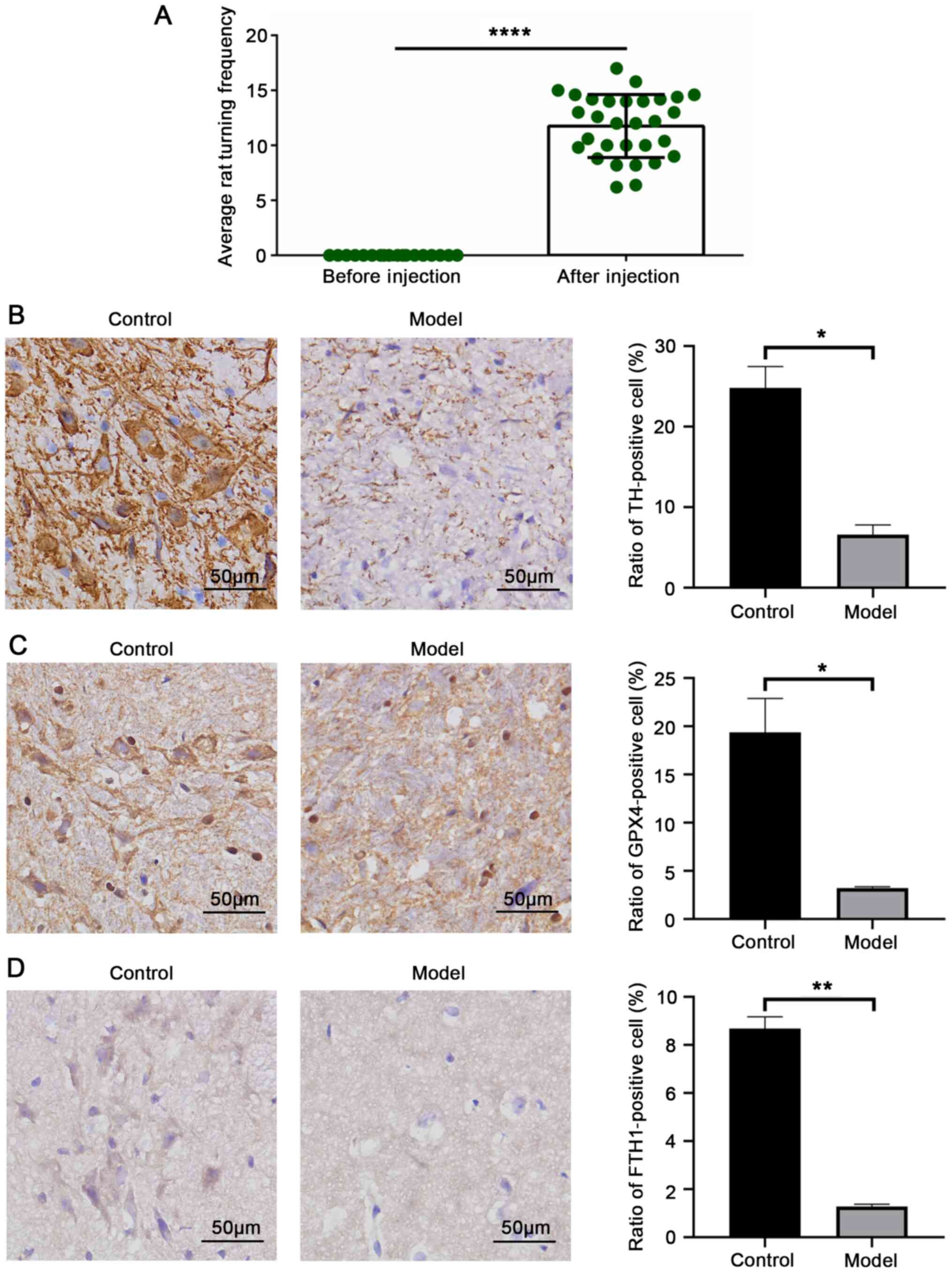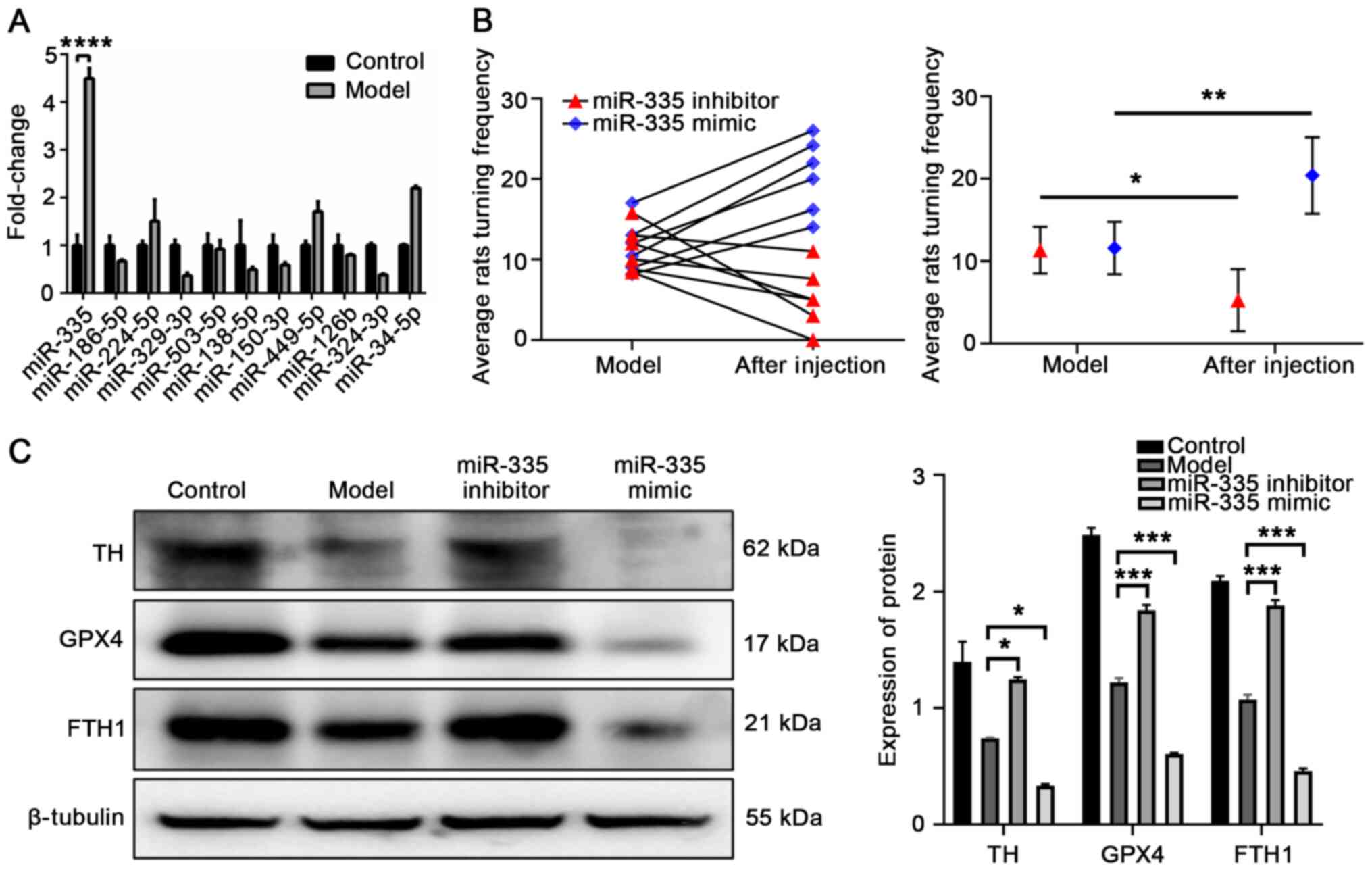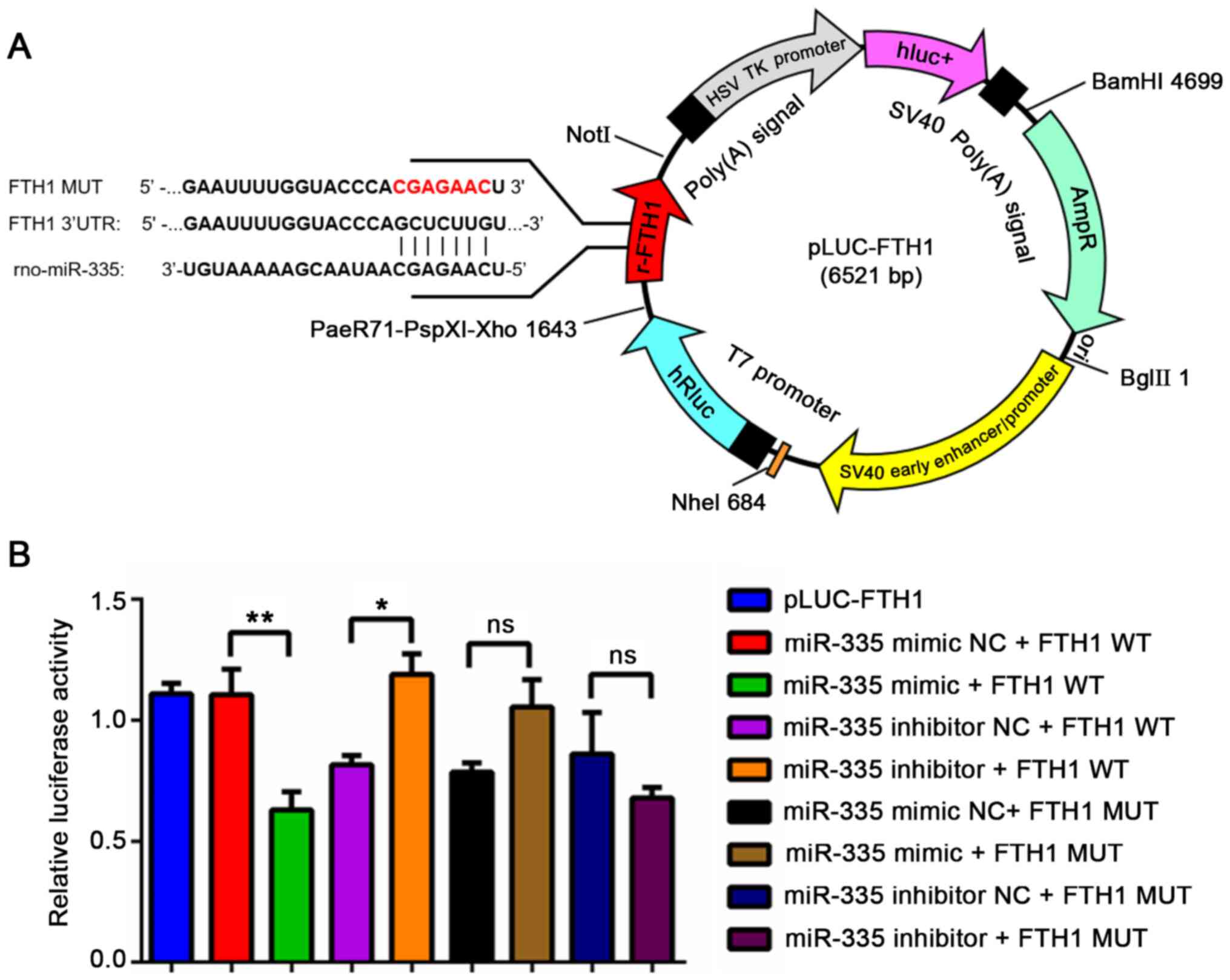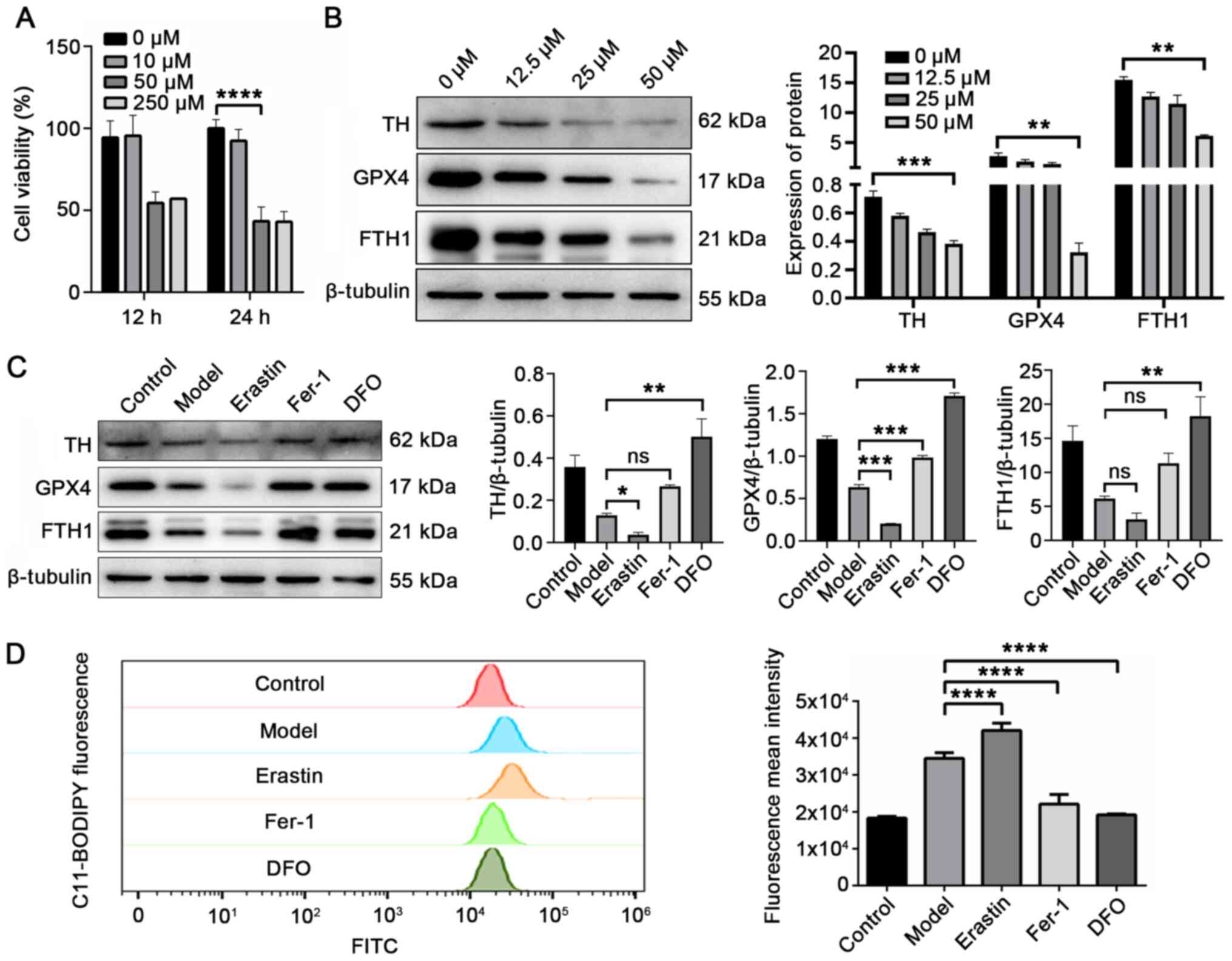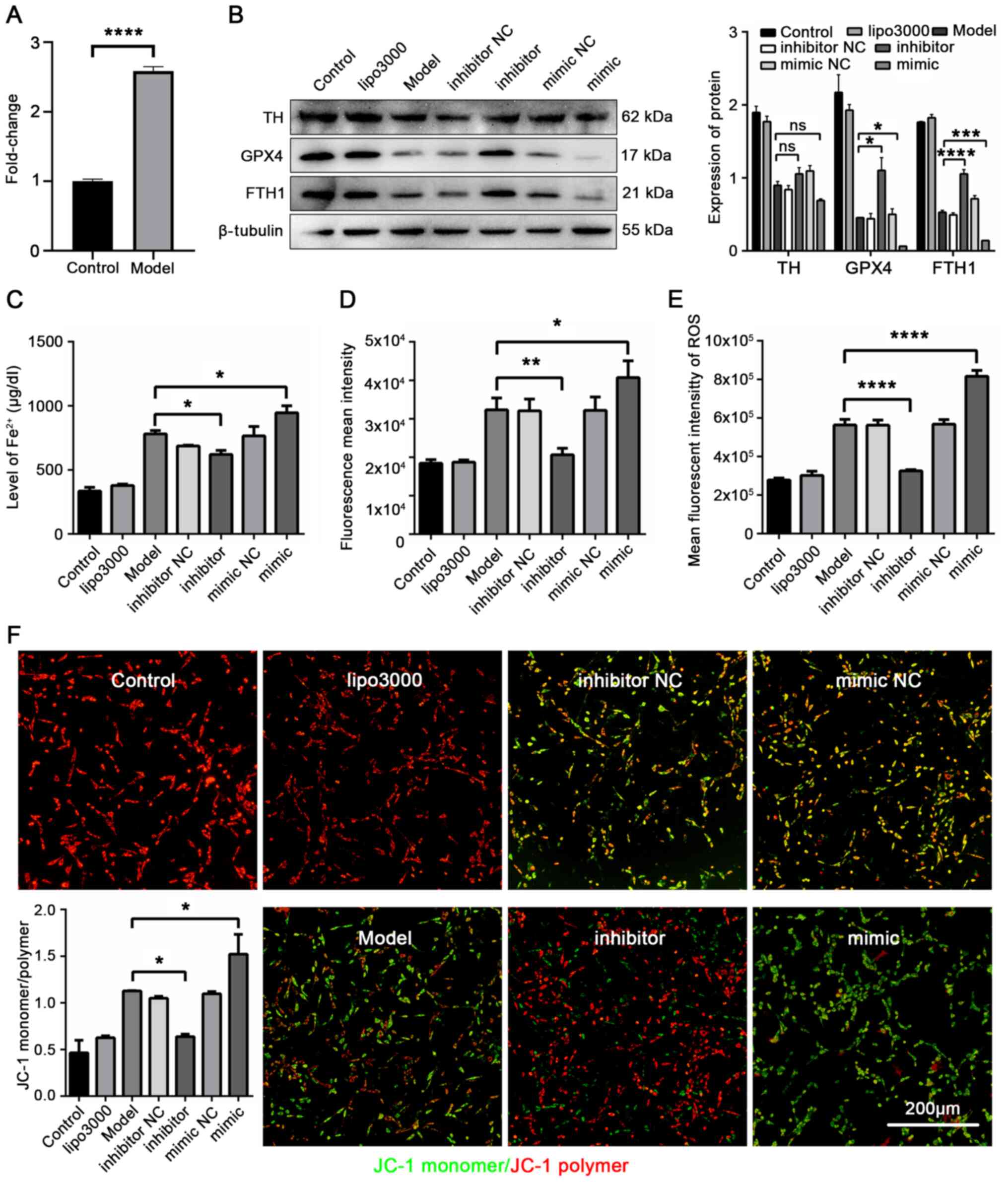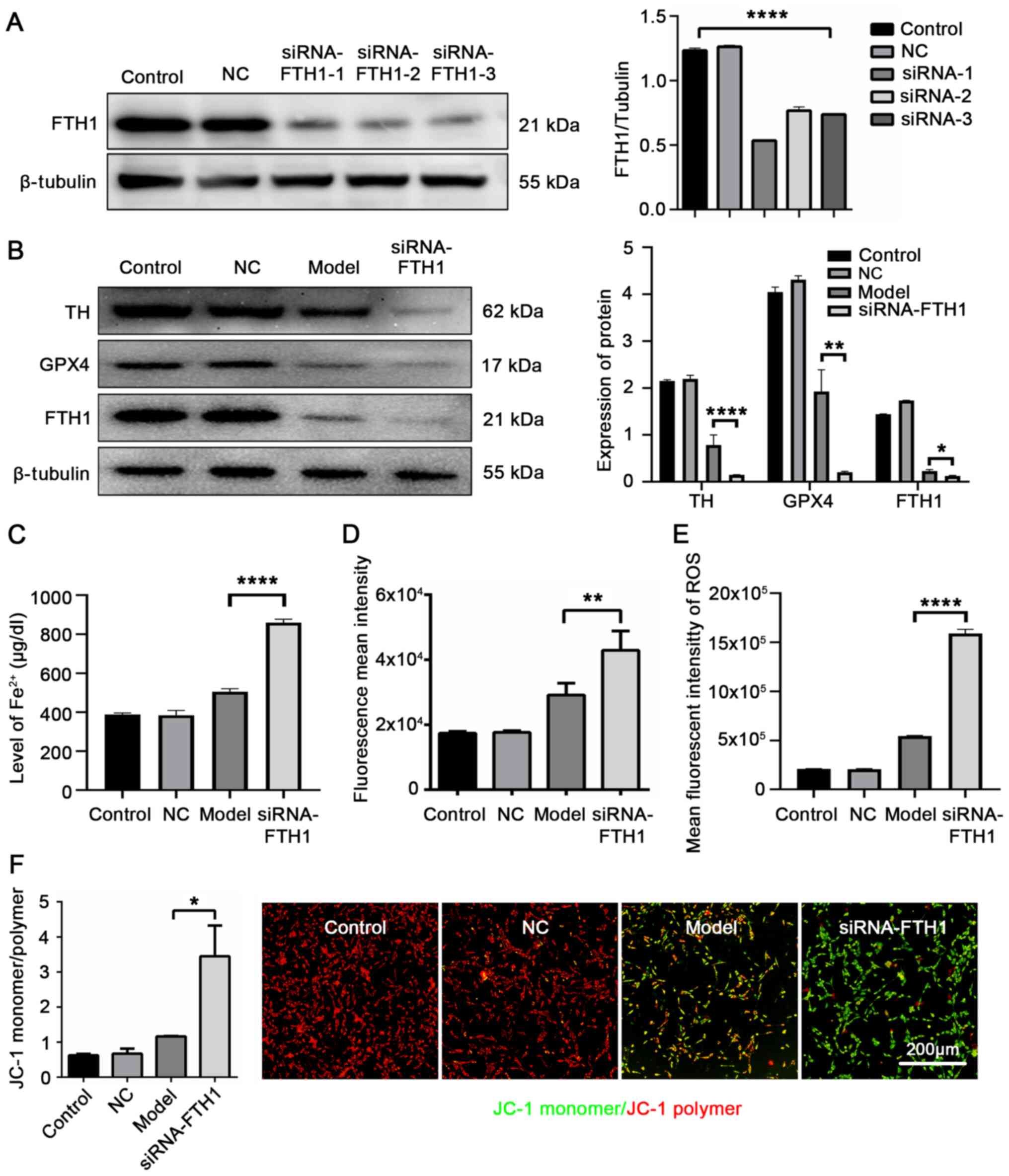|
1
|
Lei P, Bai T and Sun Y: Mechanisms of
ferroptosis and relations with regulated cell death: A review.
Front Physiol. 10:1392019. View Article : Google Scholar : PubMed/NCBI
|
|
2
|
Muhoberac BB, Baraibar MA and Vidal R:
Iron loading-induced aggregation and reduction of iron
incorporation in hetero- polymeric ferritin containing a mutant
light chain that causes neurodegeneration. Biochim Biophys Acta.
1812:544–548. 2011. View Article : Google Scholar
|
|
3
|
Yang WS, SriRamaratnam R, Welsch ME,
Shimada K, Skouta R, Viswanathan VS, Cheah JH, Clemons PA, Shamji
AF, Clish CB, et al: Regulation of ferroptotic cancer cell death by
GPX4. Cell. 156:317–331. 2014. View Article : Google Scholar : PubMed/NCBI
|
|
4
|
Yang WS and Stockwell BR: Ferroptosis:
Death by lipid peroxidation. Trends Cell Biol. 26:165–176. 2016.
View Article : Google Scholar :
|
|
5
|
Maiorino M, Conrad M and Ursini F: GPx4,
lipid peroxidation, and cell death: Discoveries, rediscoveries, and
open issues. Antioxid Redox Signal. 29:61–74. 2018. View Article : Google Scholar
|
|
6
|
Seibt TM, Proneth B and Conrad M: Role of
GPX4 in ferroptosis and its pharmacological implication. Free Radic
Biol Med. 133:144–152. 2019. View Article : Google Scholar
|
|
7
|
Forcina GC and Dixon SJ: GPX4 at the
crossroads of lipid homeostasis and ferroptosis. Proteomics.
19:e18003112019. View Article : Google Scholar : PubMed/NCBI
|
|
8
|
Xie Y, Hou W, Song X, Yu Y, Huang J, Sun
X, Kang R and Tang D: Ferroptosis: Process and function. Cell Death
Differ. 23:369–379. 2016. View Article : Google Scholar : PubMed/NCBI
|
|
9
|
Knovich MA, Storey JA, Coffman LG, Torti
SV and Torti FM: Ferritin for the clinician. Blood Rev. 23:95–104.
2009. View Article : Google Scholar :
|
|
10
|
Liu NQ, De Marchi T, Timmermans AM,
Beekhof R, Trapman-Jansen AM, Foekens R, Look MP, van Deurzen CH,
Span PN, Sweep FC, et al: Ferritin heavy chain in triple negative
breast cancer: A favorable prognostic marker that relates to a
cluster of differentiation 8 positive (CD8+) effector
T-cell response. Mol Cell Proteomics. 13:1814–1827. 2014.
View Article : Google Scholar : PubMed/NCBI
|
|
11
|
Shpyleva SI, Tryndyak VP, Kovalchuk O,
Starlard-Davenport A, Chekhun VF, Beland FA and Pogribny IP: Role
of ferritin alterations in human breast cancer cells. Breast Cancer
Res Treat. 126:63–71. 2011. View Article : Google Scholar
|
|
12
|
Sammarco MC, Ditch S, Banerjee A and
Grabczyk E: Ferritin L and H subunits are differentially regulated
on a post-transcriptional level. J Biol Chem. 283:4578–4587. 2008.
View Article : Google Scholar
|
|
13
|
Van Do B, Gouel F, Jonneaux A, Timmerman
K, Gelé P, Pétrault M, Bastide M, Laloux C, Moreau C, Bordet R, et
al: Ferroptosis, a newly characterized form of cell death in
Parkinson's disease that is regulated by PKC. Neurobiol Dis.
94:169–178. 2016. View Article : Google Scholar
|
|
14
|
Tian Y, Lu J, Hao X, Li H, Zhang G, Liu X,
Li X, Zhao C, Kuang W, Chen D and Zhu M: FTH1 inhibits ferroptosis
through ferritinophagy in the 6-OHDA model of Parkinson's disease.
Neurotherapeutics. 17:1796–1812. 2020. View Article : Google Scholar : PubMed/NCBI
|
|
15
|
Lu J, Liu X, Tian Y, Li H, Ren Z, Liang S,
Zhang G, Zhao C, Li X, Wang T, et al: Moxibustion exerts a
neuroprotective effect through antiferroptosis in Parkinson's
disease. Evid Based Complement Alternat Med. 2019:27354922019.
View Article : Google Scholar : PubMed/NCBI
|
|
16
|
Moreau C, Duce JA, Rascol O, Devedjian JC,
Berg D, Dexter D, Cabantchik ZI, Bush AI and Devos D; FAIRPARK-II
study group: Iron as a therapeutic target for Parkinson's disease.
Mov Disord. 33:568–574. 2018. View Article : Google Scholar : PubMed/NCBI
|
|
17
|
Bonn D: Pumping iron in Parkinson's
disease. Lancet. 347:16141996. View Article : Google Scholar : PubMed/NCBI
|
|
18
|
Guiney SJ, Adlard PA, Bush AI, Finkelstein
DI and Ayton S: Ferroptosis and cell death mechanisms in
Parkinson's disease. Neurochem Int. 104:34–48. 2017. View Article : Google Scholar : PubMed/NCBI
|
|
19
|
Biliński T, Krawiec Z, Liczmański A and
Litwińska J: Is hydroxyl radical generated by the fenton reaction
in vivo? Biochem Biophys Res Commun. 130:533–539. 1985. View Article : Google Scholar
|
|
20
|
Costello DJ, Walsh SL, Harrington HJ and
Walsh CH: Concurrent hereditary haemochromatosis and idiopathic
Parkinson's disease: A case report series. J Neurol Neurosurg
Psychiatry. 75:631–633. 2004. View Article : Google Scholar : PubMed/NCBI
|
|
21
|
Miyajima H, Takahashi Y and Kono S:
Aceruloplasminemia, an inherited disorder of iron metabolism.
Biometals. 16:205–213. 2003. View Article : Google Scholar : PubMed/NCBI
|
|
22
|
Borie C, Gasparini F, Verpillat P, Bonnet
AM, Agid Y, Hetet G, Brice A, Dürr A and Grandchamp B; French
Parkinson's disease genetic study group: Association study between
iron-related genes polymorphisms and Parkinson's disease. J Neurol.
249:801–804. 2002. View Article : Google Scholar : PubMed/NCBI
|
|
23
|
Rhodes SL, Buchanan DD, Ahmed I, Taylor
KD, Loriot MA, Sinsheimer JS, Bronstein JM, Elbaz A, Mellick GD,
Rotter JI and Ritz B: Pooled analysis of iron-related genes in
Parkinson's disease: Association with transferrin. Neurobiol Dis.
62:172–178. 2014. View Article : Google Scholar
|
|
24
|
Ambros V: The functions of animal
microRNAs. Nature. 431:350–355. 2004. View Article : Google Scholar : PubMed/NCBI
|
|
25
|
Bartel DP: MicroRNAs: Genomics,
biogenesis, mechanism, and function. Cell. 116:281–297. 2004.
View Article : Google Scholar : PubMed/NCBI
|
|
26
|
Bartel DP: MicroRNAs: Target recognition
and regulatory functions. Cell. 136:215–233. 2009. View Article : Google Scholar : PubMed/NCBI
|
|
27
|
Bartel DP: Metazoan MicroRNAs. Cell.
173:20–51. 2018. View Article : Google Scholar : PubMed/NCBI
|
|
28
|
Su Y, Deng MF, Xiong W, Xie AJ, Guo J,
Liang ZH, Hu B, Chen JG, Zhu X, Man HY, et al:
MicroRNA-26a/death-associated protein kinase 1 signaling induces
synucleinopathy and dopaminergic neuron degeneration in Parkinson's
disease. Biol Psychiatry. 85:769–781. 2019. View Article : Google Scholar : PubMed/NCBI
|
|
29
|
Jin L, Wan W, Wang L, Wang C, Xiao J,
Zhang F, Zhao J, Wang J, Zhan C and Zhong C: Elevated
microRNA-520d-5p in the serum of patients with Parkinson's disease,
possibly through regulation of cereloplasmin expression. Neurosci
Lett. 687:88–93. 2018. View Article : Google Scholar : PubMed/NCBI
|
|
30
|
Asci R, Vallefuoco F, Andolfo I, Bruno M,
De Falco L and Iolascon A: Trasferrin receptor 2 gene regulation by
microRNA 221 in SH-SY5Y cells treated with MPP+ as Parkinson's
disease cellular model. Neurosci Res. 77:121–127. 2013. View Article : Google Scholar : PubMed/NCBI
|
|
31
|
Rothblat DS, Schroeder JA and Schneider
JS: Tyrosine hydroxylase and dopamine transporter expression in
residual dopaminergic neurons: Potential contributors to
spontaneous recovery from experimental Parkinsonism. J Neurosci
Res. 65:254–266. 2001. View Article : Google Scholar : PubMed/NCBI
|
|
32
|
Deumens R, Blokland A and Prickaerts J:
Modeling Parkinson's disease in rats: An evaluation of 6-OHDA
lesions of the nigrostriatal pathway. Exp Neurol. 175:303–317.
2002. View Article : Google Scholar : PubMed/NCBI
|
|
33
|
Li Z, Lan X, Han R, Wang J, Huang Y, Sun
J, Guo W and Chen H: miR-2478 inhibits TGFβ1 expression by
targeting the transcriptional activation region downstream of the
TGFβ1 promoter in dairy goats. Sci Rep. 7:426272017. View Article : Google Scholar
|
|
34
|
Lee SJ, Jeong JH, Kang SH, Kang J, Kim EA,
Lee J, Jung JH, Park HY and Chae YS: MicroRNA-137 inhibits cancer
progression by targeting Del-1 in triple-negative breast cancer
cells. Int J Mol Sci. 20:61622019. View Article : Google Scholar
|
|
35
|
He H, Chen K, Wang F, Zhao L, Wan X, Wang
L and Mo Z: miR-204-5p promotes the adipogenic differentiation of
human adipose-derived mesenchymal stem cells by modulating DVL3
expression and suppressing Wnt/β-catenin signaling. Int J Mol Med.
35:1587–1595. 2015. View Article : Google Scholar : PubMed/NCBI
|
|
36
|
Livak KJ and Schmittgen TD: Analysis of
relative gene expression data using real-time quantitative PCR and
the 2(-Delta Delta C(T)) method. Methods. 25:402–408. 2001.
View Article : Google Scholar
|
|
37
|
Grayson M: Parkinson's disease. Nature.
538:S12016. View
Article : Google Scholar : PubMed/NCBI
|
|
38
|
Dixon SJ, Lemberg KM, Lamprecht MR, Skouta
R, Zaitsev EM, Gleason CE, Patel DN, Bauer AJ, Cantley AM, Yang WS,
et al: Ferroptosis: An iron-dependent form of nonapoptotic cell
death. Cell. 149:1060–1072. 2012. View Article : Google Scholar : PubMed/NCBI
|
|
39
|
Jiang H, Wang J, Rogers J and Xie J: Brain
iron metabolism dysfunction in Parkinson's disease. Mol Neurobiol.
54:3078–3101. 2017. View Article : Google Scholar
|
|
40
|
Powers KM, Smith-Weller T, Franklin GM,
Longstreth WT Jr, Swanson PD and Checkoway H: Dietary fats,
cholesterol and iron as risk factors for Parkinson's disease.
Parkinsonism Relat Disord. 15:47–52. 2009. View Article : Google Scholar :
|
|
41
|
Bellinger FP, Raman AV, Rueli RH,
Bellinger MT, Dewing AS, Seale LA, Andres MA, Uyehara-Lock JH,
White LR, Ross GW and Berry MJ: Changes in selenoprotein P in
substantia nigra and putamen in Parkinson's disease. J Parkinsons
Dis. 2:115–126. 2012. View Article : Google Scholar : PubMed/NCBI
|
|
42
|
Angelopoulou E, Paudel YN and Piperi C:
miR-124 and Parkinson's disease: A biomarker with therapeutic
potential. Pharmacol Res. 150:1045152019. View Article : Google Scholar : PubMed/NCBI
|
|
43
|
De Gregorio R: Pulcrano S, De Sanctis C,
Volpicelli F, Guatteo E, von Oerthel L, Latagliata EC, Esposito R,
Piscitelli RM, Perrone-Capano C, et al miR-34b/c regulates wnt1 and
enhances mesencephalic dopaminergic neuron differentiation. Stem
Cell Rep. 10:1237–1250. 2018. View Article : Google Scholar
|
|
44
|
Luo M, Wu L, Zhang K, Wang H, Zhang T,
Gutierrez L, O'Connell D, Zhang P, Li Y, Gao T, et al: miR-137
regulates ferroptosis by targeting glutamine transporter SLC1A5 in
melanoma. Cell Death Differ. 25:1457–1472. 2018. View Article : Google Scholar : PubMed/NCBI
|
|
45
|
Sangokoya C, Doss JF and Chi JT:
Iron-responsive miR-485-3p regulates cellular iron homeostasis by
targeting ferroportin. PLoS Genet. 9:e10034082013. View Article : Google Scholar : PubMed/NCBI
|
|
46
|
Poewe W, Bergmann L, Kukreja P, Robieson
WZ and Antonini A: Levodopa-carbidopa intestinal gel monotherapy:
GLORIA registry demographics, efficacy, and safety. J Parkinsons
Dis. 9:531–541. 2019. View Article : Google Scholar : PubMed/NCBI
|



